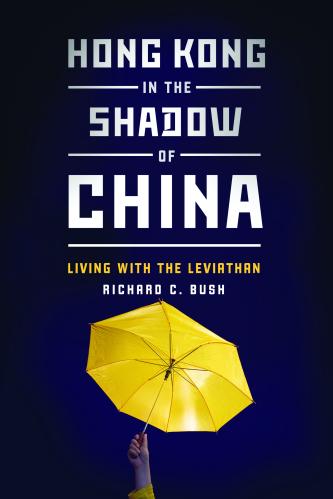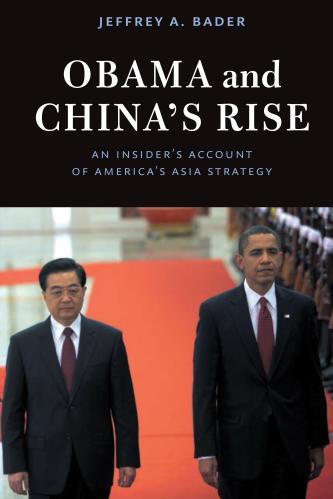The following is a light adaptation of a speech delivered at Brookings on May 9, 2019 by Senator Mark Warner (D-VA). In conversation with Brookings Nonresident Senior Fellow Victoria Nuland, Sen. Warner offered his view of China’s overseas activities and footprint. These are issues that Brookings scholars will be researching closely over the coming year as part of a new Foreign Policy initiative: “Global China: Assessing China’s growing role in the world.” This piece reflects only the view of Sen. Warner.
Until a few years ago, my views of China were pretty similar to a lot of people in the business world. As a former entrepreneur and venture capitalist, I looked at China—a rapidly modernizing country of 1.3 billion people with rising incomes and expectations—and saw mostly opportunity. At the time, I believed what a lot of people believed: that a rising China could be good for the world, and that our two countries—one a true democracy, and one inevitably headed, at least, in a less authoritarian, more open direction—could co-exist peacefully. That we could rise together as competitors, but partners nonetheless.
But a few years and many, many classified briefings later, a lot has happened to fundamentally shift my viewpoint.
Challenge of China
Under President Xi Jinping, a newly-assertive China is pursuing a sophisticated “whole-of-society” strategy that exploits all elements of state power to strengthen its position in the world and diminish U.S. power and influence.
China uses all of the traditional tools of the state to exert influence: an expanded military presence, and the aggressive deployment of espionage to steal military, and industrial secrets.
But it’s also using more creative mechanisms—that take advantage of its authoritarian model to force Chinese companies, researchers, and others to act on behalf of China’s national interests. In 2015 and 2016, China enacted new laws requiring all Chinese citizens and companies to act in support of “national security” and the Chinese government.
All of this has set the stage for China to aggressively deploy every lever of power in service to the state—and, at the same time, exploit the openness of our society to gain geopolitical and economic advantage.
The national security challenges posed by a rising China are immense. I fully acknowledge that this area includes a lot of unknown territory. But, I would also argue that we can’t wait until we have all the answers to wake up to this challenge: We have to figure out how to protect ourselves and how to compete—and win—in a changing global landscape with China as an increasingly powerful player.
Technology
Before I entered public service, I was in the technology business. As a tech guy, I see the Chinese government’s efforts to outmaneuver the U.S. technologically as one of the most alarming threats that we face.
If you’ve grown up in a post-Sputnik era, then you have only ever known a world where technological innovation was American- or Western-driven.
Just think about the technology that shaped the course of the last 60 years: the microchip, the modem, the internet, wireless communication. We developed the technology, we wrote the rules of the road, and the rest of the world followed that American standard. That was an enormous strategic and economic advantage for us in the post-World War II period, benefiting us in ways that are hard to quantify.
But now, we’re facing another Sputnik moment. In areas like 5G, artificial intelligence (AI), quantum computing, semiconductors, robotics, hypersonics, augmented reality and biotech, President Xi is making a play for first place…and he’s doing it using the model that the United States pioneered into technological dominance in the 20th century.
On 5G, China is doing exactly what we did with the development of wireless technology in the 1970s, 80s, and 90s: They’re building the equipment, developing the network, supporting it all with vast amounts of government funding, and now they’re seeking to set the global rules for the infrastructure that will power the “internet of things” over the next decades.
And China isn’t shy to employ aggressive, underhanded tactics to further an unfair edge over the
United States—tactics that go far beyond old-fashioned spycraft. Through strategic collaboration with Western companies and universities, China is able to gain access and transfer emerging technologies. Tapping into our ecosystem of innovation, China has ramped up investments in joint ventures and American start-ups in order to steal intellectual property (IP).
Disturbingly, much of this behavior is enabled by the U.S. business community, which too often looks at China through the lens of short-term market opportunities, while ignoring the longer-term risks: not only to U.S. economic competitiveness, but to their own business interests, as valuable IP is stolen and market share is taken over by their former Chinese partners.
This also creates an exposure problem, as key supply chains are put at risk as a result of reliance on foreign products.
Ominously, China is now using its newfound status as a technology powerhouse to strengthen its authoritarian model. For years, optimists in the United States were convinced Chinese efforts to regulate the internet would collapse because they would stifle the freedom and innovation needed for economic growth—and because the task of censoring one billion-plus users seemed insurmountable. Then-President Bill Clinton famously said that regulating online speech would be like trying to nail “Jell-O to a wall.”
Well, like many people, he was wrong: China has nailed its internet to the “Great Firewall.” China has successfully and scalably built a censorship infrastructure that is the envy of authoritarian regimes around the world. China is using the latest in facial recognition and machine learning to increase its surveillance and social control. The tools have become a major export by China to other authoritarian countries around the world, like Venezuela, Ethiopia, Ecuador, and Pakistan.
Even more troubling is that China has successfully recruited Western companies and researchers to assist them in their information control efforts. It’s startling that we’ve reached a point where U.S. companies and leading researchers don’t always bat an eye at working with the Chinese government on technologies used for censorship, surveillance, and social control.
Next steps
Moving forward, I believe policymakers need to think about the challenge in three different buckets:
The first is to sound the alarm. We have to wake this country up to what China is doing—this means increasing awareness for U.S. companies, universities, and others about Chinese tactics to undermine U.S. competitiveness and influence.
For this reason, I have been convening meetings between the Intelligence Community and outside stakeholders in business and academia to ensure they have the full threat picture and hopefully, make different decisions about Chinese partnerships.
Second, we need a near-term approach. We have to take a set of steps now to protect our technologies and preserve American leadership over the next one to two years.
I am concerned that this administration has not developed a coherent approach to counter China. I worry, for example, that in its trade negotiations with the Chinese, the Trump administration may undermine U.S. economic leadership and larger strategic goals in order to get minor concessions by the Chinese. Already we have seen reporting that the Trump administration has abandoned a key demand, that the Chinese cease all economic espionage.
We need to strengthen and deepen our relationships with allies who share our values. Yet at precisely the time we should be more closely aligning with our German, French, Indian, and South Korean allies (to name just a few), the current administration has, in dozens of ways—from trade to security commitments—worked to undermine those relationships. China is pouring money into Confucius Institutes and global media to export its authoritarian model. Meanwhile, the administration is insulting allies and defunding the State Department.
We cannot stand by while China moves to force its technology and standards over global telecommunications. We must work with our allies and partners to create a market for telecommunication competitors to Huawei that abide by basic security and privacy standards. This means ensuring that we are setting fair, open, and secure standards for 5G. The United States must be at the table, and standards should be chosen based on their technical rigor, not because of the geopolitical interests of China.
We need better oversight and controls to stop Chinese investments in critical and dual-use technologies given the fact that by law, all Chinese citizens and companies are ultimately beholden to the Chinese Communist Party, not their board or shareholders. I have supported Committee on Foreign Investment in the United States (CFIUS) reforms to expand oversight over these transactions, but we need to ensure implementation meets Congressional intent, and that companies can’t skirt CFIUS oversight. I’m also working on much-needed beneficial ownership legislation, so the Chinese government cannot hide their investments in shell companies to operate with anonymity in this country.
We need better tools to crack down on economic espionage and IP theft once it’s been identified. And we need to set clear expectations—and even enact federal civil and criminal prohibitions—on activities by U.S. companies and researchers that directly enable and improve censorship, surveillance, and social control efforts of authoritarian regimes.
In addition, we need to work with our universities to protect our research and development in cutting-edge technologies. This might mean better background checks for foreign students with former military or political associations, and greater oversight and even restrictions on research collaboration.
Finally, we have to have a long-term strategy. There are several steps we need to take to ensure our continued leading edge.
We need to ensure that our visa system welcomes those who want to innovate and contribute to this country, attracting talent and retain those who have been instrumental to our country’s success.
And I’m increasingly concerned, even as we out-spend every other country on defense—to the tune of $716 billion last year—that we’re just buying ourselves the best 20th-century military in the world.
Following World War II, the United States funded 69 percent of annual global R&D. Today, we fund less than 28 percent, with only 7 percent going to non-defense R&D, like wireless technology. Even if we are successful in convincing our allies that Huawei and ZTE equipment presents a serious security risk by giving China access to critical networks, we have limited alternatives to offer. This problem extends to supply chains for sensitive military technologies and platforms, where many sub-components are made in China, creating massive vulnerabilities. Without innovative and leading technologies, we cannot win the fight for the future. We need a plan for the next decade to dramatically ramp up our level of investment in foundational and emerging technologies that will set the stage for victory in the 21st century.
Bottom line is this: As a country, we have got a lot of work to do.
The Brookings Institution is committed to quality, independence, and impact.
We are supported by a diverse array of funders. In line with our values and policies, each Brookings publication represents the sole views of its author(s).








Commentary
The China challenge and critical next steps for the United States
May 15, 2019